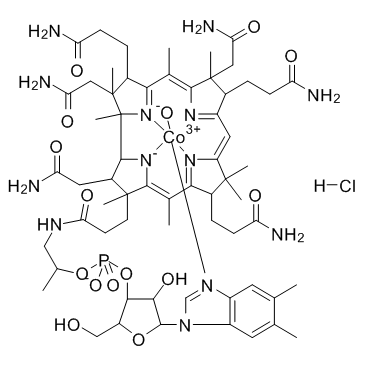Hydroxocobalamin monohydrochloride

Hydroxocobalamin monohydrochloride structure
|
Common Name | Hydroxocobalamin monohydrochloride | ||
|---|---|---|---|---|
| CAS Number | 59461-30-2 | Molecular Weight | 1381.81 | |
| Density | N/A | Boiling Point | N/A | |
| Molecular Formula | C62H89ClCoN13O15P | Melting Point | N/A | |
| MSDS | USA | Flash Point | N/A | |
|
In vivo doses of butadiene epoxides as estimated from in vitro enzyme kinetics by using cob(I)alamin and measured hemoglobin adducts: an inter-species extrapolation approach.
Toxicol. Appl. Pharmacol. 281(3) , 276-84, (2014) 1,3-Butadiene (BD) is a rodent and human carcinogen. In the cancer tests, mice have been much more susceptible than rats with regard to BD-induced carcinogenicity. The species-differences are dependent on metabolic formation/disappearance of the genotoxic BD ... |
|
|
Production benefits from pre- and post-lambing anthelmintic treatment of ewes on commercial farms in the southern North Island of New Zealand.
N. Z. Vet. J. 63 , 211-9, (2015) To measure the magnitude and variability in production responses to anthelmintic treatments administered to adult ewes around lambing.Ewes carrying twin lambs, from sheep and beef farms (eight in Year 1 and six in Year 2) in the Wairarapa region of New Zealan... |
|
|
Processing of alkylcobalamins in mammalian cells: A role for the MMACHC (cblC) gene product.
Mol. Genet. Metab. 97 , 260-266, (2009) The MMACHC gene product of the cblC complementation group, referred to as the cblC protein, catalyzes the in vitro and in vivo decyanation of cyanocobalamin (vitamin B(12)). We hypothesized that the cblC protein would also catalyze the dealkylation of newly i... |
|
|
Vitamin B12-derivatives-enzyme cofactors and ligands of proteins and nucleic acids.
Chem. Soc. Rev. 40 , 4346-4363, (2011) B(12)-cofactors play important roles in the metabolism of microorganisms, animals and humans. Microorganisms are the only natural sources of B(12)-derivatives, and the latter are "vitamins" for other B(12)-requiring organisms. Some B(12)-dependent enzymes cat... |
|
|
B12 trafficking in mammals: A for coenzyme escort service.
ACS Chem. Biol. 1 , 149-159, (2006) Many coenzymes are vitamins that are assimilated in mammals into their active form from precursors obtained from the diet. They are often both rare and reactive rendering the likelihood low that the cell uses a collision-based strategy for their delivery to d... |
|
|
A human vitamin B12 trafficking protein uses glutathione transferase activity for processing alkylcobalamins.
J. Biol. Chem. 284 , 33418-33424, (2009) Pathways for tailoring and processing vitamins into active cofactor forms exist in mammals that are unable to synthesize these cofactors de novo. A prerequisite for intracellular tailoring of alkylcobalamins entering from the circulation is removal of the alk... |
|
|
Structural basis of multifunctionality in a vitamin B12-processing enzyme.
J. Biol. Chem. 286 , 29780-29787, (2011) An early step in the intracellular processing of vitamin B(12) involves CblC, which exhibits dual reactivity, catalyzing the reductive decyanation of cyanocobalamin (vitamin B(12)), and the dealkylation of alkylcobalamins (e.g. methylcobalamin; MeCbl). Insigh... |
|
|
Adenosyltransferase: an enzyme and an escort for coenzyme B12?
Trends Biochem. Sci. 30 , 304-308, (2005) Many organic cofactors are both rare and reactive. They are usually in low abundance, which poses problems for efficient collision-based targeting to dependent enzymes, whereas their reactivity is problematic for side reactions. Sequestration and escorted del... |
|
|
Effects of hydroxocobalamin on carboxyhemoglobin measured under physiologic and pathologic conditions.
Clin. Toxicol. (Phila.) 52(7) , 647-50, (2014) Pre-hospital administration of hydroxocobalamin (B12a) is used for empiric treatment of cyanide poisoning because cyanide poisoning is difficult to identify and requires immediate treatment. B12a interferes with the accuracy of several blood laboratory tests.... |
|
|
S. Fukui, F. Korte and M. Goto, eds.
Antibiotics, Vitamins and Hormones Stuttgart , 101, (1977)
|